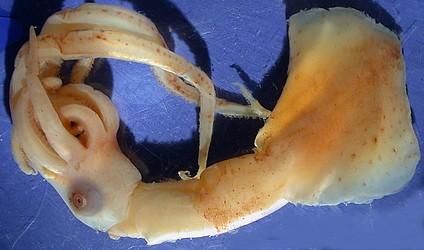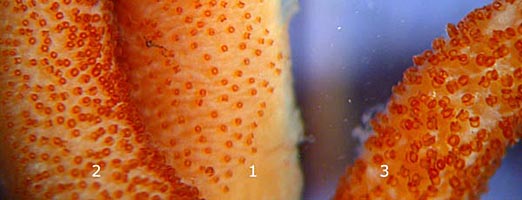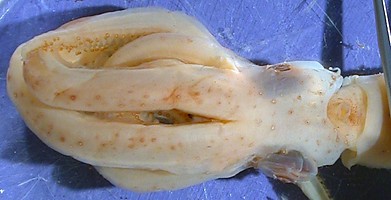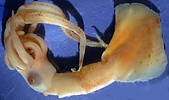Mastigoteuthis dentata
Richard E. YoungIntroduction
Hoyle (1904) based his description of M. dentata on two specimens from the Eastern Tropical Pacific off Panama, neither had tentacles. The type description with relevant notes can be seen here.
We describe here specimens taken from the central Equatorial Pacific and from the central North Temperate Pacific. At present we consider these all belong to M. dentata.
Brief diagnosis:
A Mastigoteuthis with ...
- a Pacific Ocean habitat.
- two primary rows of photophores on each arm IV.
Characteristics
- Tentacles
- Club suckers vary in size and packing density depending on position on club (a Mastigoteuthis characteristic).
- Club suckers vary in size and packing density depending on position on club (a Mastigoteuthis characteristic).
- Head
- Funnel
- Funnel locking-apparatus without a distinct antitragus.
- Posterior margin of funnel component strongly undercut, matching hook-shaped mantle component.
 Click on an image to view larger version & data in a new window
Click on an image to view larger version & data in a new window
Figure. Funnel locking apparatus of M. dentata, 48 mm ML, central equatorial Pacific. Left - Anterofrontal view of funnel component. Left middle - Frontal view of funnel component. Right middle - Frontal view of mantle component. Right - Side view of mantle component. Blue tint from methylene blue stain. Photographs by R. Young.
- Mantle
- Tubercules absent.
- Fins
- Slightly wider than long.
- Slightly wider than long.
- Photophores
- Integumental photophores in two series on arms IV.
- Eyelid photophore present and and small as in all members of Mastigoteuthis.
- Measurements
*Measurements in mm.Source Hoyle, 1904 Mantle length 72 Mantle width 17 Head width 17? Fin length 48 Fin width 52 Arm I, length: Right / Left 37 / 38 Arm II, length 44 / 47 Arm III, length 45 / 42 Arm IV, length 87 / 78
Scanning electron micrographs of the arm and tentacle suckers can be seen here.
Comments
We have examined few specimens from the Pacific Ocean. At present there are no reliable characters that separate M. dentata from M. agassizii. Genetic data is needed to determine if the Pacific form is distinct from that of the Atlantic.
Distribution
Type locality: Gulf of Panama, off Cape Mala, Panama at 7°21'N, 79°35'W. In the Central Pacific M. dentata is found in Equatorial and Temperate waters but not in between around the main Hawaiian Islands. It appears to be absent from the Eastern Pacific in waters occupied by Mastigotragus pyrodes. In the Western North Pacific it occurs as far north as the Kurile Islands (Nesis, 1982/87). In the South Pacific it is known from southern Australia, New Zealand and off central Chile and in the Indian Ocean it is known from Southern Africa (Nesis, 1982/87).
References
Hoyle, W.E. 1904. Reports on the Cephalopoda. Bulletin of the Museum of Comparative Zoology at Harvard College, in Cambridge, 43(1):1-72.
Young, R. E. 1972. The systematics and areal distribution of pelagic cephalopods from the seas off Southern California. Smithson. Contr. Zool., 97: 1-159.
Title Illustrations

| Scientific Name | Mastigoteuthis dentata |
|---|---|
| Location | Equatorial Pacific, 06°N, 150°07'W |
| Specimen Condition | Preserved |
| View | Dorsolateral |
| Size | 48 mm ML |
| Image Use |
 This media file is licensed under the Creative Commons Attribution-NonCommercial License - Version 3.0. This media file is licensed under the Creative Commons Attribution-NonCommercial License - Version 3.0.
|
| Copyright |
©

|
About This Page

University of Hawaii, Honolulu, HI, USA
Correspondence regarding this page should be directed to Richard E. Young at
Page copyright © 2014
 Page: Tree of Life
Mastigoteuthis dentata .
Authored by
Richard E. Young.
The TEXT of this page is licensed under the
Creative Commons Attribution-NonCommercial License - Version 3.0. Note that images and other media
featured on this page are each governed by their own license, and they may or may not be available
for reuse. Click on an image or a media link to access the media data window, which provides the
relevant licensing information. For the general terms and conditions of ToL material reuse and
redistribution, please see the Tree of Life Copyright
Policies.
Page: Tree of Life
Mastigoteuthis dentata .
Authored by
Richard E. Young.
The TEXT of this page is licensed under the
Creative Commons Attribution-NonCommercial License - Version 3.0. Note that images and other media
featured on this page are each governed by their own license, and they may or may not be available
for reuse. Click on an image or a media link to access the media data window, which provides the
relevant licensing information. For the general terms and conditions of ToL material reuse and
redistribution, please see the Tree of Life Copyright
Policies.
- First online 16 July 2004
- Content changed 06 December 2014
Citing this page:
Young, Richard E. 2014. Mastigoteuthis dentata . Version 06 December 2014. http://tolweb.org/Mastigoteuthis_dentata/19512/2014.12.06 in The Tree of Life Web Project, http://tolweb.org/












 Go to quick links
Go to quick search
Go to navigation for this section of the ToL site
Go to detailed links for the ToL site
Go to quick links
Go to quick search
Go to navigation for this section of the ToL site
Go to detailed links for the ToL site